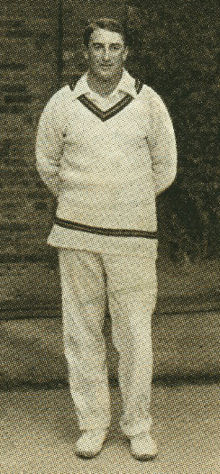Aubrey Faulkner
 |
||||||||||||||||||||||||||||||||||||||||
| Personal information | ||||||||||||||||||||||||||||||||||||||||
|---|---|---|---|---|---|---|---|---|---|---|---|---|---|---|---|---|---|---|---|---|---|---|---|---|---|---|---|---|---|---|---|---|---|---|---|---|---|---|---|---|
| Full name | George Aubrey Faulkner | |||||||||||||||||||||||||||||||||||||||
| Born |
17 December 1881 Port Elizabeth, Cape Colony |
|||||||||||||||||||||||||||||||||||||||
| Died | 10 September 1930 (aged 48) Fulham, London, England |
|||||||||||||||||||||||||||||||||||||||
| Batting style | Right-handed | |||||||||||||||||||||||||||||||||||||||
| Bowling style | Right-arm legbreak googly | |||||||||||||||||||||||||||||||||||||||
| International information | ||||||||||||||||||||||||||||||||||||||||
| National side | ||||||||||||||||||||||||||||||||||||||||
| Test debut (cap 58) | 2 January 1906 v England | |||||||||||||||||||||||||||||||||||||||
| Last Test | 28 June 1924 v England | |||||||||||||||||||||||||||||||||||||||
| Domestic team information | ||||||||||||||||||||||||||||||||||||||||
| Years | Team | |||||||||||||||||||||||||||||||||||||||
| 1902–1910 | Transvaal | |||||||||||||||||||||||||||||||||||||||
| 1912–1920 | MCC | |||||||||||||||||||||||||||||||||||||||
| Career statistics | ||||||||||||||||||||||||||||||||||||||||
|
||||||||||||||||||||||||||||||||||||||||
| Source: CricketArchive, 6 November 2009 | ||||||||||||||||||||||||||||||||||||||||
George Aubrey Faulkner (17 December 1881 in Port Elizabeth – 10 September 1930 in Walham Green, London) was a leading cricketer for South Africa for two decades.
Faulkner endured the violence of an alcoholic father before enlisting in the Imperial Light Horse in 1900 to fight in the Anglo-Boer War. After the cessation of hostilities, Faulkner moved to Johannesburg and made his first-class cricketing debut for Transvaal in the 1902/03 Currie Cup Tournament.
After playing in the Currie Cup without distinction, Faulkner came to the notice of the South African selectors when he scored a half century and took six wickets with his googlies to lead Transvaal to a surprise win over the touring 1905/06 MCC side. He was promptly selected for his Test debut in the first Test of the series against England at Johannesburg and his match figures of 6/61 helped South Africa record their maiden Test victory. Faulkner retained his place throughout the whole series and was a significant contributor to South Africa's 4-1 series victory.
Faulkner was selected for the South African tour of the United Kingdom in 1907 and his mastery of googly bowling, along with that of his team mates Reginald Schwarz, Bert Vogler and Gordon White, had a significant effect on the acceptance of wrist spin as an effective bowling weapon. The highlight of the tour for Faulkner being his spell at the Leeds Test match where he took 6/17 in eleven overs.
The return of the English side to South Africa in 1909/10 for a five Test series saw Faulkner at the height of his skills and had many, including Wisden, calling him the best all-rounder in the world, as he was the leading run scorer from either team, scoring 545 runs at 60.55 and the second highest wicket taker with 29 at 21.89. Faulkner then carried this form into his next series, against Australia in Australia in 1910/11. In the five Test series, Faulkner scored 732 runs at 73.20, including a highest score of 204 in the second Test at Melbourne and took 10 wickets at 51.40.
...
Wikipedia
